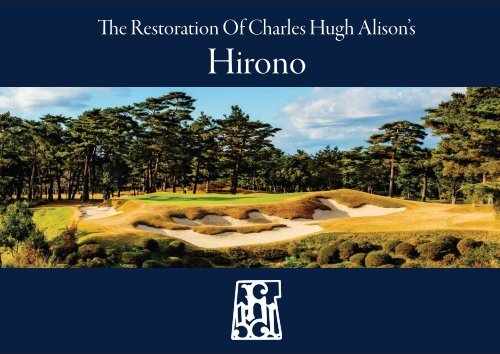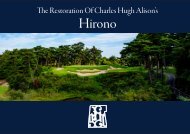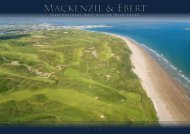You also want an ePaper? Increase the reach of your titles
YUMPU automatically turns print PDFs into web optimized ePapers that Google loves.
<strong>The</strong> <strong>Restoration</strong> <strong>Of</strong> <strong>Charles</strong> <strong>Hugh</strong> Alison’s<br />
<strong>Hirono</strong>
<strong>The</strong> <strong>Restoration</strong> <strong>Of</strong> <strong>Charles</strong> <strong>Hugh</strong> Alison’s <strong>Hirono</strong><br />
Reimagined By Mackenzie & Ebert<br />
“Beautiful lakes and pretty ponds, natural valleys and ravines,<br />
good and gentle undulations all around, rivulets, mountains,<br />
hillocks and woodlands, a real setting for an ideal golf course,<br />
all arranged by nature.”<br />
C.H.Alison
Biography <strong>Of</strong> <strong>Charles</strong> <strong>Hugh</strong> Alison<br />
<strong>Charles</strong> <strong>Hugh</strong> Alison was born on the 5th of March 1883 in Preston, Lancashire.<br />
He was educated at Malvern College in Worcestershire. He then attended New College, Oxford for two years,<br />
achieving two blues for playing for Oxford University against Cambridge University in the 1903 and 1904<br />
University Golf Matches.<br />
It is believed that Alison began to assist Harry Colt from 1906 in his course design business. In 1908, Alison<br />
was appointed secretary of Stoke Poges Golf Club (now called Stoke Park), a course which Colt designed and<br />
opened in 1909.<br />
After the war in 1918, Alison was assigned to a committee (in place of Colt) tasked with designing the four<br />
remaining holes to be designed at Pine Valley following the death of George Crump. Alison produced a five<br />
page report which led to significant changes to the course, including the rebuilding of five greens.<br />
Over the following nine years in the US, Alison designed more than twenty new courses including the Country<br />
Club of Detroit. However, it appears his experience at Pine Valley was perhaps most important in shaping his<br />
beliefs for future design work.<br />
In 1929, Colt was approached by Komo Otani from Tokyo GC.<br />
Otani studied in England and, like many other Japanese golfers<br />
who studied in Britain, he admired the courses outside London,<br />
many of which had been designed by Colt. This led to Colt<br />
agreeing to the commission and he demanded a fee of £1,500<br />
plus expenses. However, concerned by the long voyage, Colt<br />
sent Alison in his place.<br />
Alison arrived in Japan on the 1st December 1930 on a boat from<br />
California with George Penglase, an American greenkeeper who<br />
would stay on as construction foreman after Alison returned to<br />
the US. His first project was Tokyo Golf Club located on relatively<br />
flat terrain north of Tokyo which was opened in 1932. He then<br />
designed <strong>Hirono</strong>, which had a much more interesting terrain<br />
and was regarded as possibly the best golf course in Japan.<br />
He also designed the Fuji course at Kawana, though this was not completed until 1936, remodelled<br />
five holes on the (now) East Course at Kasumigaseki GC, originally created by amateur architect Kinya<br />
Fujita, and almost completely redesigned the Naruo course near Osaka.<br />
Throughout the 1930s, Alison continued to travel the world, working on the Royal Selangor course in<br />
Kuala Lumpur. He then worked in countries such as Morocco, Australia, New Zealand and South Africa.<br />
After the Second World War, in which Alison worked in ciphers, he moved to South Africa, completing<br />
minor works at some other courses. He died, aged 70, in Johannesburg on the 20th of October 1952.
<strong>The</strong> 5th hole shortly<br />
after opening
Introduction & Heritage<br />
If Mackenzie & Ebert was fortunate to be commissioned, there was a belief that this would be<br />
a project to relish when contact was first made with the committee at <strong>Hirono</strong>. <strong>The</strong> committee<br />
was named ‘<strong>The</strong> <strong>Restoration</strong> Committee’. Nothing could be closer to our hearts, especially<br />
when we saw the plans which C.H. Alison had drawn up and also the incredible archive of<br />
photographs which the Club held from the 1930s, shortly after the course opened on the 19th<br />
of June 1932. Alison had been asked to design Tokyo Golf Club but, during his 3 months in<br />
Japan, he was asked to look at numerous other sites for courses and <strong>Hirono</strong> turned out to be<br />
the most famous of them.<br />
<strong>The</strong> opportunity to view the course revealed a wonderful layout with no weak holes at all. <strong>The</strong><br />
topography could be described as ideal for golf, containing enough movement throughout<br />
without it producing a tough walk. <strong>The</strong>re are many distinct ravines and softer valleys which<br />
feature on so many of the holes. As was usual for Colt & Alison’s courses, the four par 3s really<br />
stand out as inspired although, interestingly, they are all odd numbered so surely Alison must<br />
have asked if there was much likelihood of foursomes golf being played on the course! <strong>The</strong> par<br />
5 15th is regarded by the members as perhaps the best hole but this could be partly as a result<br />
of Jack Nicklaus being the first man to hit the green in two shots in the 1960s!<br />
Following two visits to work up proposals and discuss the project with the <strong>Restoration</strong><br />
Committee, Mackenzie & Ebert was commissioned. <strong>The</strong> strong brief was to restore the great<br />
work which Alison left although, at this point, reference should be made to the significant input<br />
of Seiichi Takahata, who found the site and was also one of Club’s founders, and Chozo Itoh,<br />
the first Course Superintendent. <strong>The</strong>y were the key figures who had the task of implementing<br />
Alison’s design as he spent less than a week in Kobe to study the land and draw up his design.<br />
<strong>The</strong> wonderful character of the bunkering shown in the early photos had led to the comparison<br />
with Pine Valley although <strong>Hirono</strong> is not blessed with Pine Valley’s sandy soil. That shows what<br />
an amazing job was done by the construction team in those early days and the photograph at<br />
the top right, showing the workers in action creating the huge and beautifully shaped carry<br />
bunker at the 18th hole, illustrates the level of creation and artistry which was employed.<br />
<strong>The</strong> 18th hole under construction<br />
We added to the archive by tracking down old aerial photography of the course from the<br />
1940s and 1960s. Along with Alison’s plans and the Club’s photographs, these showed that<br />
the greens had become smaller, the fairways had become much narrower, the bunkers had<br />
lost their shape, character and roughness and the trees had grown significantly although<br />
the original course was cut through pine woodland. Only one hole had been significantly<br />
extended and, in fact, that had happened twice with new greens being pushed back on both<br />
occasions. That was the par 5 12th and the second extension had led to the par 3 13th hole<br />
being played from a new tee at right angles to Alison’s hole. <strong>The</strong> original playing line of the<br />
par 3 was something the Committee was very keen to restore back to its original playing line.<br />
We also studied the results of the most recent elite events at the course including the Japan<br />
Open of 2005 and the Japan Amateur in 2012. It was interesting to see how the holes played<br />
in those two tournaments.<br />
<strong>The</strong> 18th hole shortly after opening
<strong>The</strong> course soon after opening<br />
Note the extent of the tree cover<br />
Planning the course
Introduction & Heritage<br />
Original layout and card of the course
<strong>The</strong> view from the tee on the 2nd hole<br />
<strong>The</strong> entrance to the 6th green guarded by huge bunkers<br />
Incredible bunkering evident at the 7th hole<br />
<strong>The</strong> 17th lake & green
Introduction & Heritage<br />
Having completed all of the research, one of our main recommendations was to restore the layout and<br />
character of the bunkering although we warned that this would increase the maintenance demands.<br />
<strong>The</strong> members of the Committee were in complete agreement.<br />
<strong>The</strong> Club was also keen to rebuild the greens. Alison had drawn up green plans but the greens had<br />
been rebuilt in the 1980s when they were converted to bent grass. Our belief was that the contours<br />
were probably changed in that process. It was not the easiest task to interpret Alison’s plans but he<br />
defined the general elevations of the greens and the key features, often including quite high mounds<br />
to the rear of the greens. Our knowledge of Colt & Alison courses led us to conclude that Alison would<br />
have wanted more artfully shaped green surfaces. We invited members of the Committee to the British<br />
Isles to see and play some Colt & Alison courses and others where their input was not so significant but<br />
where the greens were good models for <strong>Hirono</strong>. We took them to St. George’s Hill, Swinley Forest, Royal<br />
Cinque Ports, Royal St. George’s, Royal County Down and Royal Portrush and that was very helpful to<br />
debate the shaping of the greens.<br />
We also recommended that the greens should be restored closer to their original sizes and to the<br />
plan shapes which Alison had drawn although his drawings showed greens meeting with bunkers as<br />
was the style at the time. Hence, we were constrained to some extent on this but the greens we have<br />
designed are much larger than those found on our initial visit.<br />
<strong>The</strong> same applied to the fairways. <strong>The</strong>y had become almost ridiculously narrow over the years. We<br />
scaled Alison’s plans and overlaid them. <strong>The</strong>y were enormously wide. <strong>The</strong> 1963 aerial photograph also<br />
showed much wider fairways although not as wide as Alison had drawn. Following consultation with<br />
the Committee, we settled on significant widening of the fairways although there was concern that<br />
this would make the course too easy. We have countered that by adding fairway bunkers to tighten the<br />
landing areas for the better players. While this falls out of the ‘restoration’ concept, we feel that this is<br />
what Alison would recommend if he had the opportunity to revisit the course today with a knowledge<br />
of how the game is now played. That same principle was applied to recommend the removal of some<br />
bunkers which were really no longer relevant, although less so than on most projects of this nature as<br />
the bunkering landscape which Alison imagined is so much a part of the character of <strong>Hirono</strong>.<br />
<strong>The</strong> trees are an interesting subject. <strong>The</strong>re is no doubt that we found too many when we made our<br />
initial visit and that significant clearance was required but the site Alison found did have a significant<br />
amount of woodland and the original course was tree lined to a large degree. Also, some of the trees<br />
which have grown or been planted have added to the beauty of the course.<br />
Golf courses in Japan have a wonderful diversity of character throughout the year. <strong>The</strong> spring sees the<br />
flowering trees, most notably the cherry trees, come to the fore. <strong>The</strong> summer heat and high rainfall<br />
results in a very green and vibrant course. In the autumn, the incredible colours and hues of the maple<br />
trees, which are interspersed amongst the pines, are a marvellous spectacle. Finally, winter takes hold<br />
but, in some ways, the playing conditions are the best and could be described as almost links like. <strong>The</strong><br />
korai (zoysia) fairways turn brown but are so tight and firm running, the noshiba grass rough turns<br />
white and the bent grass greens remain green, providing a very attractive contrast of tones.<br />
Alison’s hole plan for the 18th hole<br />
Alison’s green plan for the 18th hole
Photograph courtesy of Taku Miyamoto ©<br />
Spring<br />
Photograph courtesy of Taku Miyamoto ©<br />
Summer
Autumn<br />
Photograph courtesy of Taku Miyamoto ©<br />
Winter
<strong>The</strong> 7th hole shortly<br />
after opening
Introduction & Heritage<br />
<strong>The</strong> policy with the trees was to remove evergreen species such as leylandii, all of the imported<br />
American pines which were straight and lacking in character and to open up old vistas which<br />
had disappeared by thinning stands of woodland which had become more dense over the<br />
years. As a result, the Japanese pine trees, so many of which have wonderful shapes, have been<br />
given more freedom to be admired, some cherry trees, but not all, have been removed and the<br />
maples, in general, have been retained as their colours in the autumn produce a most amazing<br />
spectacle. Over 2,000 trees were removed during the project.<br />
<strong>The</strong> design process we followed was to make a thorough historical study to form a basis for<br />
our proposals. A Draft Masterplan was drawn up which was discussed with the Committee<br />
before a final set of proposals was agreed. <strong>The</strong>se were illustrated with visualisations based on<br />
drone photographs and presented to the membership which accepted the recommendations<br />
without any complaint or concern over the nature of the proposals or losing their course while<br />
the work was carried out. We then embarked upon the detailed design, producing green plans<br />
defining the levels of the green surfaces at 6.25cm intervals and the rest of the areas at 25cm.<br />
Existing vegetation, top soil stripping, earth movement, drainage, irrigation and proposed<br />
vegetation plans were drawn up to define the works along with a detailed specification and<br />
bill of quantities with the assistance of the Club’s General Manager, Katsuhisa Takatsuka, the<br />
Club’s Course Manager Hiroya Kitatani and the agronomist for the project, Noriaki Aoki.<br />
<strong>The</strong> large Japanese contractor Takenaka was awarded the contract aided by Nihon Turf<br />
Management working as a sub-contractor. <strong>The</strong> Club understood the need for specialist shaping<br />
skills and our feeling was that a shaper solely focusing on the bunkers would be critical for this<br />
project as well as utilising the skills of a green shaper.<br />
Quinn Thompson from Chicago, who has a lot of experience working in Japan, carried out all<br />
of the detailed bunker shaping and Raf Oczkowski, from Poland but based in Scotland, shaped<br />
up the greens and carried out the rough shaping of the bunkers before Quinn got to work.<br />
We also enlisted the input of a specialist greens finisher, Andy Bennett, to ensure that the final<br />
touches to the green contours maximised the potential of the surface shapes.<br />
<strong>The</strong> greens were built with a stone carpet and an intermediate layer and the shapes were<br />
finalised with the stone layers rather than exactly at the base stage. That worked really well<br />
with the contractor being very diligent in setting out the levels according to the detailed<br />
plans and approvals were given based on a visit schedule every three weeks. Construction<br />
commenced in early January of 2019, all of the greens were seeded before the end of May<br />
and the course reopened on 1st October 2019. <strong>The</strong> programme was very demanding but the<br />
project was completed right on schedule. That was a remarkable achievement from every<br />
member of the team given the periods of wet weather during the construction period.<br />
Photograph courtesy of Taku Miyamoto ©<br />
Captain Morimoto, Hayashi-san, Andy Bennett, Martin Ebert & Quinn Thompson
<strong>The</strong> 13th hole shortly after opening<br />
viewed from Alison’s original playing line
Introduction & Heritage<br />
Working in Japan for the first time has been a tremendous experience. <strong>The</strong> beautiful landscape<br />
has been a joy to see. <strong>The</strong> respectful nature of everyone we have met made it very easy to<br />
operate and the efficiency and hard work of the whole project team was remarkable. <strong>The</strong><br />
Club was excellent to deal with throughout and the General Manager, Katsuhisa Takatsuka<br />
coordinated all of the meetings in an extremely organised way. <strong>The</strong> Committee was led by<br />
the Club Captain, Yasunobu Morimoto and the Club’s Chairman, Kazunobu Suzuki and the<br />
President, Hidefumi Inui, have been fully supportive of the proposals.<br />
<strong>The</strong> Committee was fully engaged in the process and took a real interest in the progress of<br />
construction which is not always the case with projects like these.<br />
We hope that the golfers of <strong>Hirono</strong> will be delighted with the results of the project having been<br />
so understanding of losing their course for the best part of a year. We will have succeeded in our<br />
task if there is a sense that we have done justice to the original masterpiece of Alison, Takahata<br />
and Itoh and that we have also retained the distinctly Japanese character of the course.<br />
Photograph courtesy of Taku Miyamoto ©<br />
<strong>The</strong> <strong>Restoration</strong> Committee with President Suzuki, Martin Ebert & Chris Huggett on the Reopening Day of the Course
<strong>Charles</strong> <strong>Hugh</strong> Alison’s Original Layout
<strong>The</strong> 1932, 1948, 1963, 1976 & 2015 Aerial Photographs<br />
Historic aerial photographs almost always provide a fascinating insight into the earlier<br />
character and evolution of golf courses. <strong>The</strong>se photographs provide information regarding the<br />
green shapes and sizes, the bunker numbers, locations, sizes and shapes, the fairway widths,<br />
the extent and nature of the rough vegetation, the tree cover and the general landscape.<br />
<strong>The</strong> best photos are ones which are taken from directly overhead and can be scaled for an<br />
accurate comparison with the current day course. At <strong>Hirono</strong>, the earliest aerial photo directly<br />
overhead is from 1948. <strong>The</strong> 1932 photograph was very interesting but was taken at an oblique<br />
angle. <strong>The</strong> 1948 photograph is not very clear so the earliest photograph which provides really<br />
interesting information is from 1963 followed by the one taken in 1976. <strong>The</strong>se are wonderfully<br />
sharp photographs and really show up the greens, bunkers and fairway shapes well. <strong>The</strong>se old<br />
aerial photos illustrate how the course had evolved over the years by our comparison of them<br />
with the most recent aerial photograph of the course available.<br />
<strong>The</strong> main change to the course routing at <strong>Hirono</strong> had been the movement of the 12th green.<br />
This had been pushed further back twice since 1948 and had led to the par 3 13th hole being<br />
completely changed in playing line.<br />
One relatively frequent conclusion of these studies is that green sizes in particular have<br />
become smaller over the years due to a need to reduce the maintenance input as a result of<br />
lower manpower resources during the Second World War. In many cases, their former size was<br />
never recovered. <strong>The</strong>re was definite evidence of this at <strong>Hirono</strong>.<br />
In general, the bunkering layout of the course had remained fairly faithful to Alison’s original<br />
design. A few more had been added and some of the bunkers had seen a significant reduction<br />
in size but this was much less evident at <strong>Hirono</strong> than it is at other courses. Where the bunkers<br />
had changed was in relation to their character, with the roughness and detail being softened<br />
and smoothed out over the years. Examining the great collection of early ground photos of the<br />
course highlighted this.<br />
Another major conclusion at <strong>Hirono</strong> was that the fairways were so much wider in 1963. This is<br />
a common change to courses over the years but perhaps not to the extent that had occurred<br />
at <strong>Hirono</strong>. <strong>The</strong>re was evidence of the fairways becoming narrower between 1963 and 1976<br />
and narrower still after that. As far as the landscape was concerned, the majority of the holes<br />
were tree lined in 1948 but those tree corridors had narrowed considerably over the years.<br />
<strong>The</strong> distant views shown in the early ground photos had certainly diminished as a feature of<br />
the course with the growth of the trees. <strong>The</strong> overall historical review of the course, of which<br />
the aerial photography comparison study was a significant part, proved extremely useful for<br />
the preparation of the Masterplan and as an aid during the construction works. It has also<br />
provided a fascinating historical record for the Club.<br />
1963 Aerial Photograph
Oblique View <strong>Of</strong> <strong>The</strong> Course In 1932
Aerial Photograph <strong>Of</strong> 23rd May 1963
Evolution <strong>Of</strong> <strong>The</strong> 2nd Hole<br />
Alison’s Plan<br />
20th February 1948<br />
23rd May 1963<br />
23rd August 1976<br />
2015 - Before <strong>Restoration</strong><br />
2019 - After <strong>Restoration</strong>
Overall Summary <strong>Of</strong> Recommendations<br />
<strong>Restoration</strong> & Improvement<br />
It was decided that the project should combine both restoration and improvement of the course. For instance,<br />
it was agreed that the old 13th hole should be restored, along with many of the wonderful old bunker features<br />
shown in the historic photographs. <strong>The</strong> greens were to be restored as far as possible to Alison’s original concepts.<br />
Fairway widths were to be restored (widened) but some new bunkers added to improve the challenge of the<br />
course for the elite players.<br />
Overall Course Length<br />
<strong>The</strong>re was an opportunity to add 123 yards to the overall length of the course resulting in a total of 7,292 yards.<br />
However, the White and Red course lengths have been reduced slightly.<br />
A set of short course tees was added, giving a length of just over 4,900 yards.<br />
<strong>The</strong> 13th hole<br />
after restoration Photograph courtesy of Taku Miyamoto ©
Tees<br />
It was determined that the tees would be reconstructed to perfect levels. Some tees needed to<br />
be enlarged, some back tees added and a set of short course tees were to be included.<br />
<strong>The</strong> Carry Areas<br />
For certain holes, the grasses in the carry areas were to be allowed to grow long and wispy<br />
and it was also decided to create bare sand areas with islands of vegetation in them for some<br />
of the holes.<br />
Photograph courtesy of Taku Miyamoto ©<br />
<strong>The</strong> 3rd hole before (inset)<br />
& after restoration
Overall Summary <strong>Of</strong> Recommendations<br />
Fairways<br />
<strong>The</strong> fairways widths were to be restored back towards Alison’s original concepts but additional<br />
bunkers were also proposed to maintain the challenge of the course for the elite players.<br />
Bunkers<br />
It was unanimously agreed that the bunkers were to be restored closer to Alison’s original<br />
concept in terms of their roughness and natural looking beauty. It was felt that this would<br />
make an extremely strong visual impact for the course and a real impression in the world of<br />
golf. <strong>The</strong> success of the bunker shaping was considered to be one of the most important aspects<br />
of the project. However, it was accepted that the restoration of the bunkers to their former style<br />
would probably result in a requirement for additional maintenance and that wash outs could<br />
be an issue when heavy rain is experienced.<br />
<strong>The</strong> 2nd hole before (inset)<br />
& after restoration Photograph courtesy of Taku Miyamoto ©
<strong>The</strong> Green & Bunker <strong>Restoration</strong> At <strong>The</strong> 5th Hole<br />
Shortly After Opening<br />
Before <strong>Restoration</strong><br />
Visualisation<br />
<strong>The</strong> Completed 5th Hole
<strong>The</strong> Green & Bunker <strong>Restoration</strong> At <strong>The</strong> 7th Hole<br />
Shortly After Opening<br />
Before <strong>Restoration</strong><br />
Visualisation<br />
<strong>The</strong> Completed 7th Hole
<strong>The</strong> Sandy Carry & Bunker <strong>Restoration</strong> At <strong>The</strong> 18th Hole<br />
Shortly After Opening<br />
Before <strong>Restoration</strong><br />
Visualisation<br />
Photograph courtesy of Taku Miyamoto ©<br />
<strong>The</strong> Completed 18th Hole
Overall Summary <strong>Of</strong> Recommendations<br />
Greens<br />
In general, the plan shapes of the greens were to be<br />
restored towards the original concepts of Alison. <strong>The</strong><br />
historic research conducted led to the conclusion that<br />
the greens were much larger in size. Enlargement of the<br />
majority of the greens towards the original sizes was<br />
recommended. It was also believed that the contours<br />
of the greens were changed from the original shapes,<br />
probably when the greens were converted to bent grass<br />
in the 1980s. It was recommended that the greens were<br />
given more interesting shapes in the style which Alison<br />
would have designed.<br />
Alison’s sketch of the 3rd green<br />
<strong>The</strong> 3rd green before (inset)<br />
& after restoration
Trees<br />
<strong>The</strong> original course was tree lined but the number of trees had increased significantly and a lot of tree planting had been<br />
carried out over the years to fill any gaps in the landscape. In general, it was recommended that the removal of trees should<br />
be carried out to restore the original character and to improve the growing conditions for the greens and other playing areas.<br />
<strong>The</strong> 14th hole before<br />
(inset) & after restoration Photograph courtesy of Taku Miyamoto ©
Overall Summary <strong>Of</strong> Recommendations<br />
Practice Facilities - Putting Green<br />
<strong>The</strong> putting green used to be one fantastic large green as shown in the old photograph but it<br />
had been split into two with a pathway. It was agreed that the huge green would be restored<br />
to create an incredible feature at the clubhouse.<br />
A new, ‘Himalayas’ style putting green was thought to be a good, new feature to be added and<br />
is located beside the 10th tee for use before and after play.<br />
Practice putting green in 1933<br />
(inset) & after restoration
Practice Facilities - Practice Ground<br />
<strong>The</strong> tee for championship events was extended further back to produce a length of over 300 yards. A separate members’ tee has<br />
been constructed with an artificial tee strip behind it. <strong>The</strong> addition of double target greens with bunkers not only makes the<br />
practise more realistic but the practice ground can be closed on occasions to allow a 6 hole short course to be played.<br />
A new short game green and a bunker practice green was felt to be important so this was part of the brief for the practice<br />
ground development.<br />
Practice ground before<br />
(inset) & after
<strong>The</strong> 11th green from the approach<br />
and from above (inset)
<strong>The</strong> <strong>Restoration</strong> Process<br />
<strong>The</strong> 7th hole<br />
<strong>The</strong> 13th hole<br />
Raf Oczkowski shaping the 4th green<br />
Quinn Thompson shaping a bunker at the 6th
<strong>The</strong> 18th green<br />
Martin cycling up the 12th fairway – Environmentally responsible site transport!
<strong>The</strong> <strong>Restoration</strong> Process<br />
<strong>The</strong> 7th hole<br />
<strong>The</strong> 12th hole
Mackenzie & Ebert<br />
Tom Mackenzie & Martin Ebert have been designing and redesigning golf courses since 1989, first with Donald Steel & Company<br />
and then, from 2005, as Mackenzie & Ebert Ltd. <strong>The</strong> company has provided the golf course architectural advice to <strong>Hirono</strong> Golf<br />
Club for the restoration project following an initial visit to the Club in November 2017. Martin Ebert has been the partner in<br />
charge of the work supported by Chris Huggett. Five planning visits were made in 2018 following the initial visit and Martin<br />
made thirteen visits during the construction period between January 2019 and the reopening of the course on 1st October<br />
2019. Chris Huggett accompanied Martin on three of the construction visits to provide technical support and to record the<br />
construction works with drone photograhy.<br />
This major project at <strong>Hirono</strong> has been one of the most prominent ever handled by the company given <strong>Hirono</strong>’s standing in<br />
Japanese and world golf and the quality of <strong>Charles</strong> <strong>Hugh</strong> Alison’s original design. <strong>The</strong> company’s portfolio includes numerous<br />
Colt & Company courses around the world which helped greatly with understanding the original design concepts which would<br />
have been employed at <strong>Hirono</strong>.<br />
Royal Portrush<br />
Mackenzie & Ebert currently advise 7 of the 10 current Open Championship venues, the feted Royal Dornoch in Scotland, Royal<br />
Porthcawl in Wales, Royal County Down in Northern Ireland and Portmarnock and <strong>The</strong> Island in Ireland amongst a long portfolio<br />
of courses enjoying a strong and notable heritage. <strong>The</strong> Open Championship courses of Royal Portrush (one of Colt & Company’s<br />
finest works), Turnberry, Royal St. George’s, Royal Lytham & St Annes, Royal Troon, Carnoustie and Royal Liverpool have to<br />
present an enjoyable experience for members and visitors as well as providing a supreme test of the world’s best players.<br />
<strong>The</strong> same objective was at the core of the proposals drawn up and implemented to restore and improve the course at <strong>Hirono</strong>.<br />
Striking the right balance is always the key as well as paying due respect to the wonderful heritage of these courses. <strong>The</strong> other<br />
important aspect of the brief for <strong>Hirono</strong> was to maintain the proud Japanese character of the course.<br />
<strong>The</strong> skills which the company has learned from working on so many classic championship courses have been brought to bear<br />
on the planning and implementation of the restoration of <strong>Charles</strong> <strong>Hugh</strong> Alison’s wonderful design at <strong>Hirono</strong>. It has been a real<br />
honour to advise the Club.
Royal St. George’s<br />
Royal Troon<br />
Royal Liverpool<br />
Photograph Courtesy of Royal St. George’s<br />
Photograph Courtesy of Kenneth Ferguson Photography<br />
Photograph Courtesy of Sam Cooper<br />
Turnberry
Aerial Photograph <strong>Of</strong> <strong>The</strong> Restored Course<br />
17<br />
16<br />
18<br />
13<br />
14<br />
10<br />
12<br />
15<br />
6<br />
9<br />
11<br />
7<br />
1<br />
5<br />
4<br />
8<br />
3<br />
2
Card <strong>Of</strong> <strong>The</strong> Restored Course<br />
Hole<br />
Blue<br />
Yards<br />
White<br />
Yards<br />
Gold<br />
Yards<br />
Red<br />
Yards<br />
Green<br />
Yards<br />
1 500 488 475 475 376 5<br />
2 457 410 350 350 309 4<br />
3 462 401 349 349 349 4<br />
4 461 377 355 355 276 4<br />
5 176 139 129 129 127 3<br />
6 443 396 342 342 309 4<br />
7 217 173 147 122 122 3<br />
8 356 332 315 262 262 4<br />
9 561 491 444 444 389 5<br />
Out 3633 3207 2906 2828 2519 36<br />
10 351 334 318 318 313 4<br />
11 472 389 341 341 309 4<br />
12 604 570 456 456 456 5<br />
13 (1932) 163 134 100 100 69 3<br />
14 388 353 313 230 230 4<br />
15 592 500 444 403 403 5<br />
16 404 373 365 365 267 4<br />
17 229 207 193 193 94 3<br />
18 456 374 349 349 246 4<br />
In 3659 3234 2879 2755 2387 36<br />
Out 3633 3207 2906 2828 2519 36<br />
Total 7292 6441 5785 5583 4906 72<br />
Old Course 7169 6454 5779<br />
13 (2005) 166 145 133 123 110 3<br />
Par
Photograph courtesy of Taku Miyamoto ©
No. 1<br />
500Yds 488Yds 475Yds 475Yds 376Yds Par 5<br />
Hole Description<br />
<strong>The</strong>re is an immediate sense that an exciting experience lies in wait for the golfers when they step onto the huge 1st tee at<br />
<strong>Hirono</strong>. <strong>The</strong> tee is so close to the clubhouse and yet the location enjoys its own privacy and the view across the valley in the<br />
carry to a wide fairway is very inviting. Alison’s huge, flanking bunkers on either side of the fairway provide an indication<br />
that the bunkering of the course will be one of its strong characteristics. One bunker has been added to the left of the<br />
fairway to tighten the landing area for the longest hitters. <strong>The</strong> fact that the hole plays as a short par 5 is a comfort to most<br />
golfers but, for major events, it is normally played as a par 4 so that makes it an entirely different and more demanding<br />
prospect. <strong>The</strong> approach bunker on the right gives the fairway beautiful shape. This hazard works well with the huge scar<br />
of a bunker which is located to the left of the green, in a natural deep swale which Alison would have selected as the key<br />
feature to set his green beside. <strong>The</strong> green surface has a number of distinct areas for the location of the flag and the major<br />
feature is a spine which divides its left and right from the green centre onwards.<br />
Hole Changes & Comments<br />
Trees thinned to the right of the hole.<br />
Bunkers restored and reshaped.<br />
Fairway restored in width and shape along the lines of Alison’s concept.<br />
1. Existing tee rebuilt.<br />
2. Short course tee built.<br />
3. Bunker filled.<br />
4. New bunker added.<br />
5. Approach bunker widened towards centre line.<br />
6. Approach area widened considerably to the right.<br />
7. Green restored in size and shape to Alison’s design.<br />
8. Bunker filled behind the green.<br />
9. Trees cleared behind the green.<br />
1<br />
4<br />
8<br />
5 6<br />
7<br />
9<br />
2 3
No. 1
Photograph courtesy of Taku Miyamoto ©
No. 1
Photograph courtesy of Taku Miyamoto ©
Photograph courtesy of Taku Miyamoto ©
No. 2<br />
457Yds 410Yds 350Yds 350Yds 309Yds Par 4<br />
Hole Description<br />
<strong>The</strong> tees of the 2nd are reached by a short, uphill walk and the higher elevation provides the golfers with a wonderful<br />
view of the hole stretching away in the distance. <strong>The</strong> low point of the fairway is the landing area for the tee shots, with the<br />
green involving the gentlest of climbs from that point. However, the view is broken by the most marvellous cross bunker<br />
stretching from right of the centre line to the furthest point possible to the left. <strong>The</strong> restoration of the magnificence of this<br />
great hazard was a real priority but the best players now carry it with ease. Hence, a new bunker has been located to the<br />
right of the fairway which will pose a real decision for the golfers on the tee. <strong>The</strong> fairway tightens up significantly at this<br />
point. Any lay up will leave a much longer second shot up the slope to a demanding green so there is a real benefit to be<br />
gained from a long and accurate drive. <strong>The</strong> approach and the green are guarded by a quartet of bunkers. <strong>The</strong> golfers are<br />
learning quickly that Alison liked to defend his greens very stoutly!<br />
Hole Changes & Comments<br />
Trees thinned to the right of the hole.<br />
Bunkers restored and reshaped.<br />
Fairway restored in width and shape along the lines of Alison’s concept.<br />
1. Existing tees rebuilt.<br />
2. Short course tee built.<br />
3. Trees cleared to the left of the carry to open up views of the bunkers again.<br />
4. Carry bunker restored to one large hazard.<br />
5. Trees cleared and a new fairway bunker added.<br />
6. Trees cleared to the left of the fairway.<br />
7. Approach and greenside bunker configuration restored.<br />
8. Green restored in size and shape to Alison’s design and moved to the right by 5 yards.<br />
9. Trees cleared behind the green.<br />
1<br />
3<br />
4<br />
6<br />
7<br />
2<br />
5<br />
7<br />
8<br />
9
No. 2
Photograph courtesy of Taku Miyamoto ©
No. 2
Photograph courtesy of Taku Miyamoto ©
Photograph courtesy of Taku Miyamoto ©
No. 3<br />
462Yds 401Yds 349Yds 349Yds 349Yds Par 4<br />
Hole Description<br />
Once again, the tees are so easily reached from the previous green. Alison located another fearsome carry bunker but on<br />
the right this time, and not so far across the fairway as the one at the 2nd. <strong>The</strong> carry of the hole is a low area and that has<br />
now been landscaped with a mixture of sand and islands of rough, a characteristic which a number of holes on the course<br />
now share. <strong>The</strong>se naturalised areas certainly add to the drama of the view from the tees.<br />
With no opportunity to take the tee back and no desire to move Alison’s huge bunker further on, a new bunker has been<br />
added further up to the right of the hole. <strong>The</strong> elevated green has a beautifully shaped bunker guarding its left hand side<br />
and that balances well with the pond to the right.<br />
Hole Changes & Comments<br />
Trees thinned on both sides of the hole.<br />
Bunkers restored and reshaped.<br />
Fairway restored in width and shape along the lines of Alison’s concept.<br />
1. Existing tees rebuilt and enlarged.<br />
2. Short course tee built.<br />
3. Bare sand area created in the carry.<br />
4. Trees cleared to allow the full extent of the large carry bunker to be restored.<br />
5. Trees cleared to the right and a new fairway bunker added.<br />
6. Green restored in size and shape to Alison’s design.<br />
1<br />
3<br />
2<br />
6<br />
4 5
No. 3
Photograph courtesy of Taku Miyamoto ©
No. 3
Photograph courtesy of Taku Miyamoto ©
Photograph courtesy of Taku Miyamoto ©
No. 4<br />
461Yds 377Yds 355Yds 355Yds 276Yds Par 4<br />
Hole Description<br />
<strong>The</strong> only green which has been moved as part of this project is at the 4th, although the 12th green had been taken further<br />
on twice during its evolution. Moving it to the right slightly has created welcome space for the walk off side to the 5th tees<br />
but the shape and bunkering around the green has taken Alison’s original design as its inspiration. <strong>The</strong> green had to come<br />
a little closer towards the tees as well but the new back tee has more than made up for the loss of length at the green. <strong>The</strong><br />
new tee also means that the original, staggered fairway bunkers are at the perfect distance for the best players. <strong>The</strong>y will<br />
be aiming to just about carry the one on the left but not run into the one on the right.<br />
<strong>The</strong> bunkers have both been edged in towards the fairway to demand more accuracy. <strong>The</strong> green is surrounded by bunkers<br />
apart from in the approach and to the left but, on that side, a steep bank will see an errant shot kicking away from the<br />
green, leaving a tricky recovery.<br />
Trees thinned to the right of the hole.<br />
Bunkers restored and reshaped.<br />
Fairway restored in width and shape along the lines of Alison’s concept.<br />
1. New back tee added lengthening the hole by 10 yards despite some loss of length at<br />
the green end of the hole.<br />
2. Existing tees rebuilt.<br />
3. Trees cleared to the right of the carry.<br />
4. Short course tee built.<br />
Hole Changes & Comments<br />
5. Bunkers on the left and right extended into the fairway to tighten the drive landing<br />
area.<br />
6. Trees cleared to allow the green to be moved shorter and to the right to give more<br />
room to the left of the green but Alison’s design used for the green shape and<br />
bunkering.<br />
5<br />
1<br />
2<br />
3<br />
4<br />
5<br />
6
No. 4
No. 4
Photograph courtesy of Taku Miyamoto ©
Photograph courtesy of Taku Miyamoto ©
No. 5<br />
176Yds 139Yds 129Yds 129Yds 127Yds Par 3<br />
Hole Description<br />
<strong>The</strong> run of three extremely demanding par 4s (four in major events when the 1st is played as a par 4), is broken by the world<br />
class, par 3 5th hole. However, even though it is undeniably world class, there will be golfers who might prefer the 7th or the<br />
13th. Even the 17th is a strong one-shot hole. It is true to say that <strong>Hirono</strong> has an embarrassment of riches when it comes to<br />
par 3s. That is common amongst the designs of Harry Colt and <strong>Charles</strong> <strong>Hugh</strong> Alison but it is unlikely that any of their other<br />
courses will be quite as well-endowed on this front.<br />
<strong>The</strong> deep, water filled ravine which lies between the tees and the green provides the visual drama but Alison produced a<br />
hole of the highest quality with a quite brilliantly bunkered green. <strong>The</strong> huge hazard which slices so strongly across the front<br />
of the green and up its right hand side looked so stunning in the early photos of the course and every attempt has been<br />
made to replicate the same visual impression from the tee. A very short tee shot which just clears the ravine leaves the<br />
golfer faced with possibly the second hardest bunker shot at <strong>Hirono</strong>. <strong>The</strong> hardest one comes two holes later in the deepest<br />
pit short of the par 3 7th!<br />
Bunkers restored and reshaped.<br />
1. New back tee added lengthening the hole by 24 yards.<br />
2. Existing tees rebuilt and enlarged.<br />
3. Trees and bushes cleared to reveal the reservoir and to open up the surroundings<br />
around the green.<br />
Hole Changes & Comments<br />
4. <strong>The</strong> incredible looking large bunker restored.<br />
5. Alison’s original green design restored using his plans and the old photographs of<br />
the green from the tee to replicate the look of the bunkers and the horizon line of<br />
the back of the green.<br />
3<br />
3<br />
1<br />
2<br />
3<br />
3<br />
4<br />
3<br />
5
No. 5
Photograph courtesy of Taku Miyamoto ©
No. 5
Photograph courtesy of Taku Miyamoto ©
Photograph courtesy of Taku Miyamoto ©
No. 6<br />
396ds<br />
443Yds 342Yds 342Yds 309Yds Par 4<br />
Hole Description<br />
Alison’s plan of the 6th proposed a carry bunker but no photos exist which provide evidence that this was ever created.<br />
Instead, at some point, a large mound was constructed, resulting in a blind tee shot. It is a slightly strange feature and a<br />
little odd to introduce unnecessary blindness but it fits perfectly with the dominant central mound to the rear of the green<br />
and, indeed, the form of some of the mountains surrounding the course.<br />
<strong>The</strong> decision was taken to add Alison’s intended bunker and, further, to occupy the low area from the tees leading to it<br />
with a sandy landscape which joins into the bunker itself. This produces a breath-taking view from the tee. Another, smaller<br />
mound has been added to the right of the tee shot to maintain the character of the other features of the hole and the<br />
bunkers on either side of the green frame the putting surface perfectly.<br />
Hole Changes & Comments<br />
Trees thinned on both sides of the hole.<br />
Bunkers restored and reshaped.<br />
Fairway restored in width and shape along the lines of Alison’s concept.<br />
1. New back tee added lengthening the hole by 18 yards.<br />
2. Existing tees rebuilt.<br />
3. Short course tee built.<br />
4. Bare sand area created which joins into the bunker set into the mound. Alison showed<br />
this bunker on his plans but the old ground and aerial photography does not suggest<br />
it was ever built.<br />
5. <strong>The</strong> existing bunker has been edged into the fairway.<br />
6. Trees thinned to the right of the hole to reveal the steep drop away.<br />
7. Trees cleared to the left of the hole to allow the fairway to be extended.<br />
8. A new mound created to the right of the fairway to tighten the landing area.<br />
9. Green restored in size and shape to Alison’s design.<br />
10. Trees cleared behind the green.<br />
1<br />
2<br />
4<br />
5<br />
7<br />
10<br />
3<br />
6<br />
6<br />
8<br />
9
No. 6
Photograph courtesy of Taku Miyamoto ©
No. 6
Photograph courtesy of Taku Miyamoto ©
Photograph courtesy of Taku Miyamoto ©
No. 7<br />
217Yds 173Yds 147Yds 122Yds 122Yds Par 3<br />
Hole Description<br />
<strong>The</strong> name which the 7th hole was known by, Devil’s Divot, really explains it all! From the back tee it requires a shot of over<br />
200 yards. to reach the green. This plays across a tremendously deep ravine, running from left to right across the hole, which<br />
saves its deepest section for the area in front of and to the right of the green. Alison chose to fill this with unimaginable<br />
bunkers and sandy wastes resulting in a vision from the tee which can fill the golfer with the most worrisome of thoughts.<br />
A tee shot falling well short will definitely leave the hardest bunker shot at <strong>Hirono</strong>!<br />
Trust and belief in the swing is required and the relief of finding the green surface is one of the most satisfying outcomes<br />
on the course. <strong>The</strong> green is not the largest but has an excellent variety of flag positions to ensure that the hole tests the<br />
putting as well as the long game.<br />
Bunkers restored and reshaped.<br />
1. Back tee extended to the rear lengthening the hole by 6 yards.<br />
2. Existing tees rebuilt and enlarged.<br />
3. Trees cleared on both sides of the hole to open it out again.<br />
4. Short course tee built.<br />
5. New bridge built across the valley.<br />
6. Bare sand area created in the carry.<br />
Hole Changes & Comments<br />
7. Larger area of green surround created to the left with a steep slope running away from<br />
the green replacing a bunker which was not in Alison’s design.<br />
8. Green restored in size and shape to Alison’s design.<br />
9. Bunker behind the green which was not in Alison’s plan removed and replaced with a<br />
closely mown bank and swale.<br />
10. Trees cleared behind the green.<br />
3<br />
1 4<br />
5<br />
7<br />
10<br />
2<br />
3<br />
6<br />
8<br />
9
No. 7
Photograph courtesy of Taku Miyamoto ©
No. 7
Photograph courtesy of Taku Miyamoto ©
Photograph courtesy of Taku Miyamoto ©
No. 8<br />
356Yds 332Yds 315Yds 262Yds 262Yds Par 4<br />
Hole Description<br />
Every course of the highest quality should have at least one short par 4 and <strong>Hirono</strong> has two excellent examples at the 8th<br />
and 10th. Neither would be regarded as driveable apart from by the very longest hitters in the game. <strong>The</strong> presence of the<br />
pond cutting into the approach of the 8th means that there is not much sense in trying to drive the green but the most<br />
powerful might give it a second thought. <strong>The</strong> carry exhibits another sandy landscape and the requirement of the tee shot<br />
is a matter of avoiding the two fairway bunkers on the right and leaving a good distance for the pitch.<br />
<strong>The</strong> green is protected by an impressive, sprawling, diagonally running bunker up its right hand side and there is another<br />
one lurking behind the green. <strong>The</strong> green itself is divided into a number of sections at different levels so only an accurately<br />
judged approach will leave a simple birdie putt and any real miscue will mean that a 3 putt is more likely than not.<br />
Trees thinned to the right of the hole.<br />
Bunkers restored and reshaped.<br />
Fairway restored in width and shape along the lines of Alison’s concept.<br />
1. Existing tees rebuilt.<br />
2. Trees thinned right of the tees.<br />
3. Short course tee built.<br />
4. Bamboo cut back dramatically on both sides of the carry.<br />
Hole Changes & Comments<br />
5. Bare sand area created in the carry.<br />
6. Both fairway bunkers edged towards the centre line of the hole.<br />
7. Green restored in size and shape to Alison’s design.<br />
8. Bamboo removed at the rear of the green and replaced by mounding.<br />
4<br />
1<br />
5<br />
8<br />
2<br />
3<br />
4 6<br />
7
No. 8
Photograph courtesy of Taku Miyamoto ©
No. 8
Photograph courtesy of Taku Miyamoto ©
Photograph courtesy of Taku Miyamoto ©
No. 9<br />
561Yds 491Yds 444Yds 444Yds 389Yds Par 5<br />
Hole Description<br />
<strong>The</strong> new back tee which plays out of a chute in the pine trees at the 9th will mean that the longest players will have to take<br />
note of the large bunker to the right of the hole. <strong>The</strong> hole doglegs elegantly from left to right and has <strong>Hirono</strong>’s clubhouse<br />
as a beckoning backdrop to the green.<br />
A valley cuts across the approach and leaves the putting surface sitting high above deep and intricately shaped bunkers<br />
to the left, right and rear. <strong>The</strong> two behind the green did not appear in Alison’s plans but they do in old photos of the hole<br />
and add visual beauty to the view from the clubhouse terrace. Hence, it was decided that they should be included in the<br />
project.<br />
Trees thinned on both sides of the hole.<br />
Bunkers restored and reshaped.<br />
Hole Changes & Comments<br />
Fairway restored in width and shape along the lines of Alison’s concept.<br />
1. New back tee added lengthening the hole by 19 yards with trees cleared around the<br />
tees to make the drive playable.<br />
2. Existing tees rebuilt.<br />
3. Trees removed to the right of the carry to open up the line to the right side of the<br />
fairway.<br />
4. Short course tee built.<br />
5. Fairway bunker edged into the fairway.<br />
6. Trees thinned to the left of the approach and green to allow sight of the beautiful<br />
bridge.<br />
7. Right hand greenside bunker extended around the front of the green.<br />
8. Green restored in size and shape to Alison’s design.<br />
9. Bunkers shown in the old photos restored to the rear of the green.<br />
4<br />
6<br />
1<br />
2<br />
3 5<br />
7<br />
8<br />
9
No. 9
Photograph courtesy of Taku Miyamoto ©
No. 9
Photograph courtesy of Taku Miyamoto ©
Photograph courtesy of Taku Miyamoto ©
No. 10<br />
351Yds 334Yds 318Yds 318Yds 313Yds Par 4<br />
Hole Description<br />
<strong>The</strong> short par 4 10th hole has a fairway with a lovely shape around another beautiful and huge cross bunker breaking<br />
across the hole from the right. That bunker disguises the view of the hole from the tee and adds to the uncertainty of which<br />
club to take. <strong>The</strong> bunker to the left of the fairway has been extended towards the fairway and a new bunker added on the<br />
right to further complicate the decision about how far and where to place the tee shot.<br />
<strong>The</strong> green is one of a kind. Alison raised it high up above the generally flat terrain and completely encircled it with deep and<br />
fearsome bunkers. <strong>The</strong> wonderful view of Mount Mekko in the distance behind the green has been restored by significant<br />
tree and bush clearance.<br />
Trees thinned on both sides of the hole.<br />
Bunkers restored and reshaped.<br />
Hole Changes & Comments<br />
Fairway restored in width and shape along the lines of Alison’s concept.<br />
1. Back tee raised slightly to enhance the view of the green.<br />
2. Existing tee rebuilt.<br />
3. Himalayas putting green created to the left of the tees.<br />
4. <strong>The</strong> edges of the carry bunkers first added at some point since 1976 but which<br />
appeared in Alison’s original plan have been reshaped.<br />
5. Left hand bunker extended into the fairway to tighten the landing area.<br />
6. New fairway bunker added on the right to provide some risk to the elite players trying<br />
to drive close to the green.<br />
7. Green restored in shape to Alison’s design.<br />
8. Bushes cleared and trees thinned to the rear of the green to restore the distant views<br />
of Mount Mekko.<br />
3<br />
4<br />
5<br />
8<br />
1<br />
2<br />
6<br />
7
No. 10
Photograph courtesy of Taku Miyamoto ©
No. 10
Photograph courtesy of Taku Miyamoto ©
Photograph courtesy of Taku Miyamoto ©
No. 11<br />
472Yds 389Yds 341Yds 341Yds 309Yds Par 4<br />
Hole Description<br />
<strong>The</strong> shortest par 4 on the course is followed by the longest with the 472 yard 11th hole providing a real test of power to<br />
reach the green in two shots. <strong>The</strong> drive plays over a deep and wide valley to a fairway which is almost flat. However, two<br />
huge bunkers eat into that fairway from the right, tightening the landing area the further up the tee shots are hit. <strong>The</strong>se<br />
two hazards balance well with the left hand line of three approach bunkers which have been edged marginally towards the<br />
centre line of the hole to demand a second shot of the utmost accuracy.<br />
<strong>The</strong> green is large but has a strong ridge running from its left side which makes it difficult to reach the rear left quadrant<br />
when the flag is located there.<br />
Trees thinned on both sides of the hole.<br />
Bunkers restored and reshaped.<br />
Fairway restored in width and shape along the lines of Alison’s concept.<br />
1. Back tee moved back further lengthening the hole by 14 yards.<br />
2. Existing tees rebuilt.<br />
3. Trees removed in the carry.<br />
4. Short course tee built.<br />
5. Both of the fairway bunkers have been extended into the fairway.<br />
Hole Changes & Comments<br />
6. Trees selectively cleared and the undergrowth has been removed to open up the<br />
views.<br />
7. <strong>The</strong> approach bunkers have been edged into the line of play slightly.<br />
8. Green restored in size and shape to Alison’s design.<br />
9. Trees cleared to the rear of the green.<br />
1<br />
2<br />
3<br />
6<br />
7<br />
5<br />
4 8<br />
9
No. 11
Photograph courtesy of Taku Miyamoto ©
No. 11
Photograph courtesy of Taku Miyamoto ©
Photograph courtesy of Taku Miyamoto ©
No. 12<br />
604Yds 570Yds 456Yds 456Yds 456Yds Par 5<br />
Hole Description<br />
<strong>The</strong> longest par 4 on the course is followed by the longest par 5 and the 12th edges beyond 600 yards making it a true<br />
three shot hole for all but the most powerful players in the game. That length has been gained by two extensions of the<br />
hole from Alison’s original design. In the modern age, where power has meant that most par 5s are cut down to two shots<br />
to reach the putting surface, it was felt that it was appropriate to retain the green where it had been moved to rather than<br />
restoring it to Alison’s original position.<br />
<strong>The</strong> challenge of the hole is complicated by the approach being tightened by some beautiful Japanese pines. Despite the<br />
green not being an original, it did not seem out of place amongst the other 17 on the course although it was given some<br />
new contouring.<br />
Trees thinned on both sides of the hole.<br />
Bunkers restored and reshaped.<br />
Hole Changes & Comments<br />
Fairway restored in width and shape along the lines of Alison’s concept.<br />
1. Trees have been cleared around the tees to restore the original views.<br />
2. Existing tees rebuilt.<br />
3. Short course tee built.<br />
4. Tree clearance carried out along the left of the hole to open up distant views of the<br />
mountains.<br />
5. Approach bunker edged in slightly to tighten the landing area for the second shots.<br />
6. An approach bunker on the left has been removed.<br />
7. Trees cleared to the left of the green to reveal distant views.<br />
8. This green was not original but has been reconstructed to tie in perfectly with the<br />
style of the other 17 putting surfaces.<br />
1<br />
7<br />
2<br />
4<br />
6<br />
8<br />
3<br />
5
No. 12,13 & 14
Photograph courtesy of Taku Miyamoto ©
No. 12
Photograph courtesy of Taku Miyamoto ©
Photograph courtesy of Taku Miyamoto ©
No. 13<br />
1932 Hole<br />
2005 Hole<br />
163Yds<br />
166Yds<br />
134Yds<br />
145Yds<br />
100Yds<br />
133Yds<br />
100Yds<br />
123Yds<br />
69Yds<br />
110Yds<br />
Par 3<br />
Par 3<br />
7<br />
8<br />
2005<br />
10<br />
Hole Description<br />
It was one of the key objectives of the <strong>Restoration</strong> Committee that the original<br />
line of the par 3 13th should be investigated and restored if at all possible. <strong>The</strong><br />
wonderful, historic photographs of the hole provided real inspiration for this. When<br />
the 12th hole was extended the second time, the tees for the 13th were moved to a<br />
position at 90 degrees to the original line and it did not take long for the woodland<br />
to smother out all signs of the old platforms. It was felt that the walk back to the<br />
original tees would be too long and back into the play of the 12th but a safe route<br />
has been found through the trees and well worth a few extra yards of walking. <strong>The</strong><br />
view from the tee, down to the green, across the reservoir and its beautiful stone<br />
bridge is one of the finest on the course. Having said that, the newer hole has real<br />
beauty to it as well so it was decided that two holes should be produced from one.<br />
<strong>The</strong> green has been set up to accept shots from both angles to provide real variety.<br />
6<br />
9<br />
6<br />
1932<br />
5<br />
4<br />
3<br />
Trees thinned on both sides of the hole.<br />
Bunkers restored and reshaped<br />
Hole Changes & Comments<br />
1<br />
2<br />
1. New back tee added on the restored line of the hole.<br />
2. <strong>The</strong> restored old tee recreates the original line and the iconic view of the hole.<br />
3. Trees thinned to allow enough light to the restored tees.<br />
4. <strong>The</strong> original line of the hole<br />
5. New pathway routed through the woodland from the 12th green.<br />
6. Two new short course tees built.<br />
7. <strong>The</strong> other line of the hole is a good one so has been maintained as well.<br />
8. Existing tees rebuilt and widened.<br />
9. <strong>The</strong> green has been reconfigured to accept tee shots from both angles and the bunkering restored to that shown in<br />
the old photo.<br />
10. Trees and bushes cleared to open up the surroundings around the green.
No. 13
Photograph courtesy of Taku Miyamoto ©
No. 13
Photograph courtesy of Taku Miyamoto ©
No. 13
Photograph courtesy of Taku Miyamoto ©
Photograph courtesy of Taku Miyamoto ©
No. 14<br />
388Yds 353Yds 313Yds 230Yds 230Yds Par 4<br />
Hole Description<br />
Alison probably felt that it was a bit of a challenge to regain the elevation lost at the 13th hole with the start of the return<br />
towards the clubhouse at the 14th. However, he found some high ground above the 13th green for the tees and set up a<br />
tee shot to one of the widest fairways he drafted on his set of plans. That must have been to accommodate the huge slope<br />
in the ground with the high plateau on the right giving a level shot into the green and the much lower level on the left<br />
leaving a shorter but blind approach.<br />
Over the years, the fairway had become much narrower from the left and the trees had claimed the lost ground. It was<br />
decided to restore Alison’s original intention of the hugely wide fairway but to add a central bunker to provide focus from<br />
the tee and strategy to the hole. <strong>The</strong> green is another which is beautifully located and protected by no less than six bunkers.<br />
Hole Changes & Comments<br />
Bunkers restored and reshaped.<br />
Fairway restored in width and shape along the lines of Alison’s concept.<br />
1. Existing tees rebuilt.<br />
2. Trees removed to open up the views to the fairway.<br />
3. Lower bunker has been restored to the shape it was in 1963.<br />
4. Major tree clearance to the left of the hole has been carried out revealing the stream.<br />
5. Two short bunkers to the right of the hole have been removed. <strong>The</strong>y were not shown<br />
on Alison’s original plan.<br />
6. Woodland cleared to allow the fairway to be extended dramatically to the left to<br />
provide a low landing area.<br />
7. Central fairway bunker has been added to divide the landing areas.<br />
8. Fairway extended to the right bunker to maximise the area on the top plateau.<br />
9. Green restored in size and shape to Alison’s design.<br />
10. Trees thinned behind the green to reveal beautiful pines.<br />
1<br />
4<br />
6<br />
10<br />
2<br />
3<br />
7<br />
8<br />
9<br />
5
No. 14
Photograph courtesy of Taku Miyamoto ©
No. 14
Photograph courtesy of Taku Miyamoto ©
Photograph courtesy of Taku Miyamoto ©
No. 15<br />
592Yds 500Yds 444Yds 403Yds 403Yds Par 5<br />
Hole Description<br />
<strong>The</strong> par 5 15th is one of the favourites of the members with its leaps across two valleys. <strong>The</strong> first, which is the deeper one,<br />
must be taken on after the tee shot and the second immediately in front of the green. <strong>The</strong> tee shot plays across sand areas<br />
in the carry and a sentinel pine stands guard to the left of the fairway, complicating the second shot of anyone who has not<br />
hit the drive far enough from the tee or far enough to the right.<br />
<strong>The</strong> hole swings round to the left towards the green which is defended by four more of Alison’s bunkers with the front<br />
hazard being the dominant one both in playing and visual terms.<br />
Hole Changes & Comments<br />
Bunkers restored and reshaped.<br />
Fairway restored in width and shape along the lines of Alison’s concept.<br />
1. New back tee added lengthening the hole by 24 yards.<br />
2. Old back tee widened to the right to gain a better shape.<br />
3. Bare sand areas created in the carry.<br />
4. Existing tees rebuilt with the main tee lowered slightly.<br />
5. Forward tee moved nearer to the old location on the right.<br />
6. Short course tee built.<br />
7. Fairway extended to the bunker on the right.<br />
8. Bushes cleared from the mounds between the two holes<br />
9. Bunker has been cut up into the mounding to make the sand line more visible.<br />
10. Fairway pulled back towards the cross bunkers.<br />
11. Tree clearance carried out to the right of the green to help its condition.<br />
12. Green restored in size and shape to Alison’s design.<br />
12<br />
1<br />
2<br />
3<br />
4<br />
3<br />
11<br />
5<br />
6<br />
7<br />
10<br />
8<br />
9
No. 15
No. 15
Photograph courtesy of Taku Miyamoto ©
No. 16<br />
404Yds 373Yds 365Yds 365Yds 267Yds Par 4<br />
Hole Description<br />
<strong>The</strong> 16th is a medium length par 4 with a tee shot which plays across a deep ravine to an undulating fairway. Alison did<br />
not show any fairway bunkers but one has been added to the right of the hole to make the landing area a little more<br />
demanding. <strong>The</strong>re is an advantage in flirting with this by hitting a long tee shot to reach an area beyond the lowest point<br />
in the fairway. That will leave a short approach but it must be accurate to a green perched up in level and which has a very<br />
undulating surface.<br />
<strong>The</strong> key feature of the green is a strong spine running from one of Alison’s characteristic mounds located to the rear of the<br />
green.<br />
Trees thinned on both sides of the hole.<br />
Bunkers restored and reshaped.<br />
Fairway restored in width and shape along the lines of Alison’s concept.<br />
1. Line of hedge behind the back tee removed.<br />
2. Existing tees rebuilt.<br />
3. Trees cleared in the carry to allow more of a view to the left side of the hole.<br />
4. Short course tee built.<br />
5. Trees thinned to open up the hole to the left.<br />
Hole Changes & Comments<br />
6. New fairway bunker added to the right of the hole to tighten the landing area for<br />
the elite players.<br />
7. Green restored in size and shape to Alison’s design.<br />
8. Trees removed to the right of and behind the green.<br />
1<br />
3<br />
5<br />
7<br />
8<br />
2<br />
8<br />
4 6
No. 16
Photograph courtesy of Taku Miyamoto ©
No. 16
Photograph courtesy of Taku Miyamoto ©
Photograph courtesy of Taku Miyamoto ©
No. 17<br />
229Yds 207Yds 193Yds 193Yds 94Yds Par 3<br />
Hole Description<br />
Alison’s plan of the par 3 17th hole showed a pond extending right up the left side of the hole ending up level with the rear<br />
of the green. A smaller version was formed, stopping well short of the green. That has been remedied by clearing trees and<br />
extending the water body but it still takes a bad shot to find it as there is a beautifully shaped bunker between the green<br />
and the pond.<br />
<strong>The</strong> tee shot is quite an experience, playing across another area of water which is a huge reservoir before the approach is<br />
reached. It is the longest par 3 on the course and the green is demanding, so it is no easier than the other challenging short<br />
holes of the layout.<br />
Hole Changes & Comments<br />
Bunkers restored and reshaped.<br />
Fairway restored in width and shape along the lines of Alison’s concept.<br />
1. Existing tees rebuilt.<br />
2. Trees cleared and the pond extended as shown in Alison’s plans as this was never<br />
carried out.<br />
3. Trees thinned to the right of the hole to allow light to the green.<br />
4. Green restored in size and shape to Alison’s design.<br />
2<br />
4<br />
1<br />
3
No. 17
Photograph courtesy of Taku Miyamoto ©
No. 17
Photograph courtesy of Taku Miyamoto ©
Photograph courtesy of Taku Miyamoto ©
No. 18<br />
456Yds 374Yds 349Yds 349Yds 246Yds Par 4<br />
Hole Description<br />
Every great course should have a finishing hole to match and, despite the fine quality of the 17 holes which have preceded<br />
it, there is almost a feeling that the best has been kept until last at <strong>Hirono</strong>. <strong>The</strong> 18th traces a fantastic arc from right to left<br />
first over a sandy carry and then across the largest bunker on the course. That is quite a statement bearing in mind how<br />
large many of the other bunkers are but, along with its size, it has the most incredible shaping and runs diagonally across<br />
the carry and up the left side of the hole. <strong>The</strong> old photographs of the construction and earliest years of the bunker have<br />
provided tremendous inspiration for its restoration. It is certainly a stunning sight again from the tee. Another fairway<br />
bunker has been added to the right of the hole to tighten the drive for the longest hitters. Having negotiated the first part<br />
of the hole, the second shot must pass a huge approach bunker and thread the gap between dangerous and deep left and<br />
right greenside bunkers. <strong>The</strong> green and its rear bunker is in the view of the members in the clubhouse across the huge<br />
putting green and the clubhouse pond. Yet another of the best views at <strong>Hirono</strong>.<br />
Hole Changes & Comments<br />
Trees thinned on both sides of the hole.<br />
Bunkers restored and reshaped.<br />
Fairway restored in width and shape along the lines of Alison’s concept.<br />
1. Existing tees rebuilt.<br />
2. Bare sand area created in the carry area.<br />
3. Magnificent carry bunker has been restored.<br />
4. Short course tee built.<br />
5. Trees cleared to the left of the hole to open up a view towards the green from the tees.<br />
6. Trees cleared and a new bunker added to the right of the hole to tighten the landing<br />
area for the longer hitters.<br />
7. Green restored in size and shape to Alison’s design.<br />
8. Bank converted to a tightly mown slope behind the green.<br />
9. <strong>The</strong> wonderful bunker behind the green has been recreated as this is such an<br />
important part of the view from the clubhouse.<br />
9<br />
1<br />
2<br />
5<br />
7<br />
8<br />
3<br />
4<br />
6
No. 18
Photograph courtesy of Taku Miyamoto ©
No. 18
Photograph courtesy of Taku Miyamoto ©
Conclusion<br />
<strong>The</strong> <strong>Restoration</strong> Committee’s brief was clear in the desire to restore the great characteristics of <strong>Charles</strong> <strong>Hugh</strong> Alison’s<br />
original and inspired design which has meant so much to golf in Japan. When the restoration process began, it was agreed<br />
that a worthy objective to include in the brief was the addition of some features, most notably bunkers, to strengthen the<br />
test posed for the best players in the game.<br />
We hope that if Mr. Alison was able to return to <strong>Hirono</strong> today, he would be proud of what he achieved during his visit in<br />
early January 1931 and what Takahata-san and Ito-san implemented after that visit and that he would also be pleased with<br />
what has been achieved in this <strong>Restoration</strong> project carried out in 2019.<br />
Mackenzie & Ebert would like to take this opportunity to thank the <strong>Restoration</strong> Committee and the President, Captain<br />
and members of <strong>Hirono</strong> Golf Club for their trust in us and their hospitality and friendly approach througout the project.<br />
We hope that much enjoyment will be taken by the members and their visitors from playing the restored course of the great<br />
<strong>Charles</strong> <strong>Hugh</strong> Alison.
Photograph courtesy of Taku Miyamoto ©
Mackenzie & Ebert<br />
International Golf Course Architects

















